There is simply no escaping the fact that 2022 has started out with a completely different sound than a resounding and joyful ‘bang!’ Perhaps we can charitably say it began with a dull, familiar thud – likely caused by the simultaneously slapping of foreheads across the world when the latest wave of pandemic restrictions were announced. As the famous baseball player and manager Yogi Berra once said, “It’s like déjà vu all over again.”
To avoid dwelling on the dour present, let’s turn back the clock to the spring of 2021, a more innocent time when our knowledge of boosters and PCR technology was a trifle less developed. The setting is a warehouse in Lachine, Quebec, the new home of CarbiCrete, a McGill spinoff who, quite simply, aim to build a better world.
A group of visitors is clustered (socially distanced, even in those bygone times) around a glass-walled machine, roughly the shape and size of a phone booth. There is a low-pitched whirring noise that lasts about a minute and then a sudden, satisfying ‘snap!’
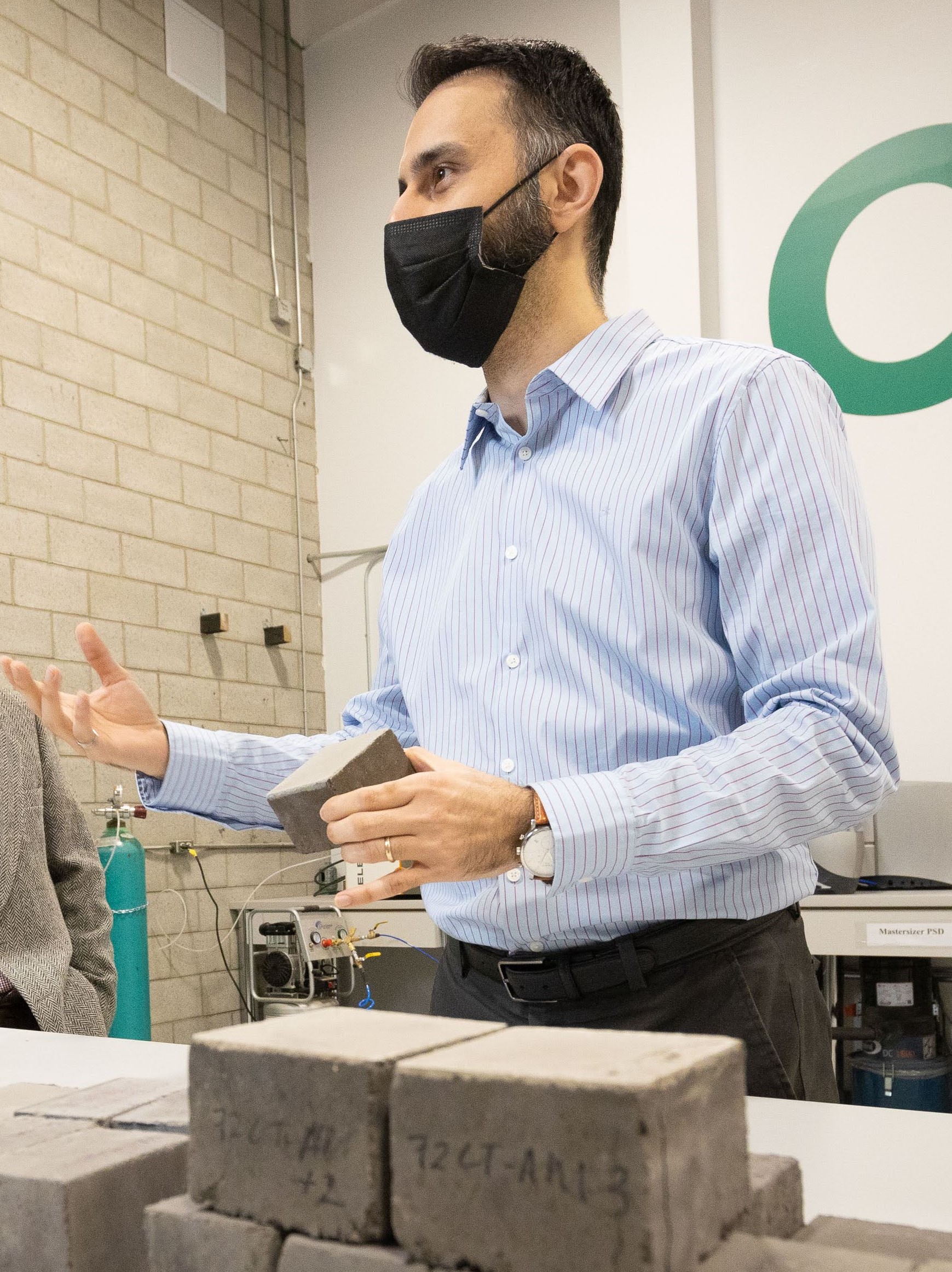
The sample in question was part of a new product line the company is developing: paving stones. And while this may not seem to be the most glamorous item to be developing, it is important to understand that these are no ordinary stones.
“The real trick is getting the colour that we want,” Mahoutian elaborated. “Aesthetics are much more important in paving stones than CMUs, so we have to get this right.”
Modern-day alchemy
Like a form of modern-day alchemy, CarbiCrete has found a way to turn base materials into ‘gold,’ which in this day and age means captured carbon. To illustrate what this means, a basic understanding of concrete is in order.
First of all, it is fundamental to understand that cement and concrete are not the same. Cement is an ingredient in concrete, a kind of glue if you will, that binds the other materials (what is referred to as aggregate) together.
Human beings have been working with some kind of pourable building material that eventually sets into a permanent and durable form, for millennia. The first use of concrete is believed to have been in what is now called Turkey, some 12,000 years ago.
Romans were experts in the stuff, as exemplified by the Pantheon in Rome. Although well over 2,000 years old, it is to this day the largest domed concrete structure of its kind anywhere in the world.
But the cement formula developed by the Romans was lost to antiquity; what we now know as cement was developed in 1824 by Joseph Aspdin, who combined calcium, silica, aluminum, and iron to make what was eventually called Portland cement.
Since that time, Portland cement – which is mixed with sand and gravel to form concrete - quickly became the construction material of choice, to the extent that is the most consumed substance in the world next to water.
Concrete use weighs on the entire world
 What effect is all that concrete guzzling having on the world? Here is one example: it is estimated that the Three Gorges Dam in China, which is the world’s largest single concrete mass, is so incredibly heavy it actually moved the earth’s axis by 2 centimeters. For the record, the dam is made of 28 million cubic meters of concrete.
What effect is all that concrete guzzling having on the world? Here is one example: it is estimated that the Three Gorges Dam in China, which is the world’s largest single concrete mass, is so incredibly heavy it actually moved the earth’s axis by 2 centimeters. For the record, the dam is made of 28 million cubic meters of concrete.
The problem is that the very process by which cement is made requires significant amount heat, anywhere from 1,350 to 1,550 °C (2,460 to 2,820 °F). All of this requires a lot of energy, which results in significant emissions of greenhouse gases.
But it is also in the chemical reactions that take place (the ‘calcination’ process) that CO2 is released. Taken altogether, the cement industry generates 8% of the world’s greenhouse gases. In 2019, that amounted to 2.3 billion tons of CO2.
In comparison, commercial aviation is estimated to issue 2% of the world total. Indeed, if the cement industry was a country, it would be the world’s fourth largest emitter, next to the U.S.A., China, and India.
With such a volume of emissions, what is the solution? Enter CarbiCrete and their ‘golden’ formula. The historically minded will recall that the study of alchemy sought to turn base metals like lead and copper into gold. While they never succeeded, CarbiCrete may have found a new winning formula.
Making blocks without cement
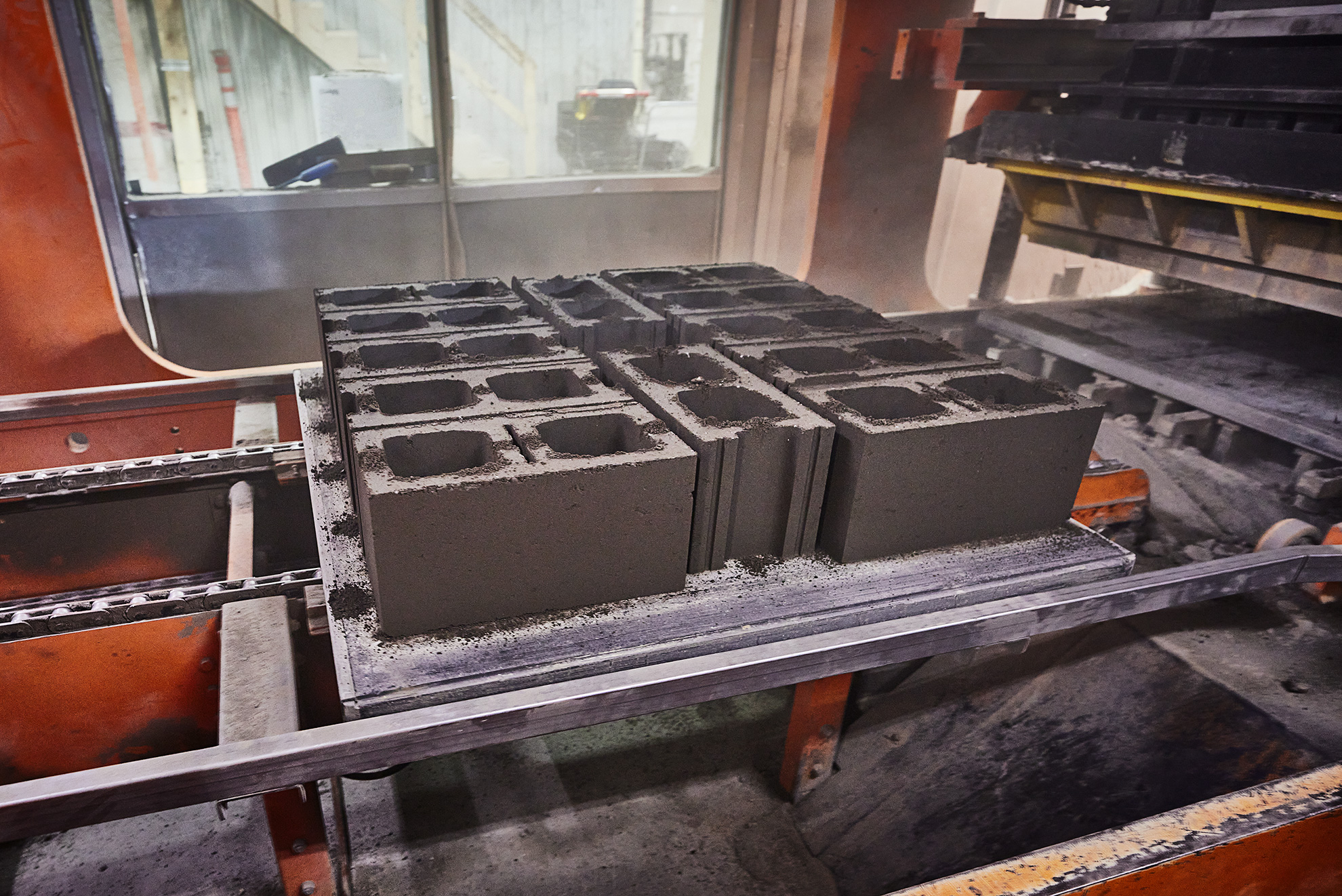 CarbiCrete CEO, Chris Stern, explained: “In its current production method, it is impossible to decarbonize cement. So, the simplest thing to do is to get rid of the cement.”
CarbiCrete CEO, Chris Stern, explained: “In its current production method, it is impossible to decarbonize cement. So, the simplest thing to do is to get rid of the cement.”
This is made possible by replacing the cement with a substitute, which in the case of CarbiCrete is steel slag, or the waste material generated when making steel.
“There’s not many uses for steel slag, but in addition to that, we use CO2 in the curing process. So it does four things: it uses less energy, it avoids emissions, it uses waste materials, and it captures carbon,” said Stern. “All of this in a product your grandmother could understand.”
What Stern is referring to is CarbiCrete’s stock and trade: Concrete Masonry Units (CMUs), otherwise known as cinderblock, or the large, heavy concrete blocks that make up garages – and plenty of other buildings – the world over.
Traditional production technique for a CMU involves pouring the raw materials into a mold and then letting them cure for a given period of time. But CarbiCrete cures its blocks with CO2, which makes each block not just carbon neutral, but carbon negative, to the tune of one kilogram of carbon trapped in each block. To put that in perspective, consider that the global market for CMUs and bricks was estimated at 1.9 trillion units in 2020.
Scaling up with partner support
While this may sound too good to be true, there is a small catch: how to do this at scale. For that, it is necessary to reach out and find partners. Although CarbiCrete may have found the magic formula, they have no plans to actually make billions of units on their own.
Enter Drummondville-based Patio Drummond, a family business with about 80 employees whose main activity is producing and selling concrete materials for commercial and residential use. Already a company that was, according to marketing director Philippe Girardin, “famous for our craziness to try new products,” news of a technique to reduce carbon content in CMUs piqued their interest.
They approached CarbiCrete to find out more. “It was shocking to think there was no cement powder,” recalled Girardin when they inspected an early CMU. They quickly agreed to begin a test phase and began adapting their plant to handle the new technique.
“The first day of the first test, the block came out perfect,” said Girardin. “The tech is 100% working.” The company moved through two phases, each involving a scale up of production capacity. They recently announced they were entering Phase III of the plan: 25,000 CMUs per day, which represents 100% of their capacity. In other words, they are all in.
Someone else who is all in is Florence Genest. A Project Analyst at CarbiCrete, she began working with the company in 2018, the year that she completed a Master’s degree in Environmental Engineering at Ecole Polytechnique.
Ask any student looking for a job after graduating, and most will admit that finding something in their field of study is a bit of a pie-in-the-sky. For Genest, however, not only did the role at CarbiCrete fit with her environmental education, but also her business background – she did an undergraduate degree in sustainable business at Montreal’s HEC.
“Combining business and cleantech was a really good fit,” she said. Those skills were put to good use as she was involved in overseeing the integration of their technology into Patio Drummond’s manufacturing facility.
Getting attention: awards and investment
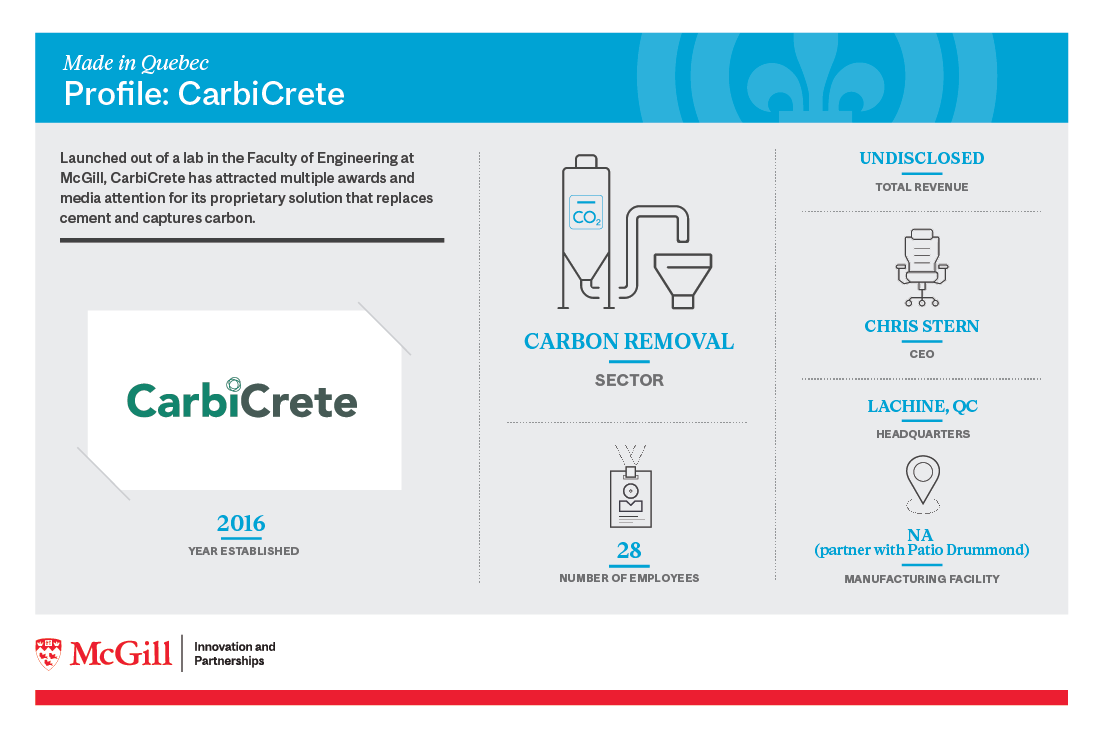 But Patio Drummond wasn’t the first industry player to notice CarbiCrete’s innovation – far from it. Not only has the company won multiple awards, such as twice being named to the Global Cleantech 100, or being a finalist in the NRG COSIA Carbon XPRIZE, but it has also attracted significant investment from a major industry player: Harsco Corporation (NYSE: HSC).
But Patio Drummond wasn’t the first industry player to notice CarbiCrete’s innovation – far from it. Not only has the company won multiple awards, such as twice being named to the Global Cleantech 100, or being a finalist in the NRG COSIA Carbon XPRIZE, but it has also attracted significant investment from a major industry player: Harsco Corporation (NYSE: HSC).
In 2019, Harsco announced it had taken a stake in the Quebec-based firm. But there are other big names also interested in CarbiCrete’s product.
“A large warehouse retailer asked us to supply them with 8,000 bricks for a building they were erecting in Oregon,” confided Stern. “And a beauty product retailer also wanted CMUs for a flagship store in Florida.” Although they were not in a position to fulfill those requests – CarbiCrete does not manufacture its own products – the boost to their reputation was most welcome.
As their status as an innovative company rises, it also helps burnish the increasing perception of Quebec as a cleantech hub. Due to its long history of hydroelectric power thanks to Hydro Quebec, the province has been pushing hard in spurring the development of related technologies. For example, it is a leader in the electric bus market not just in Canada, but across North America.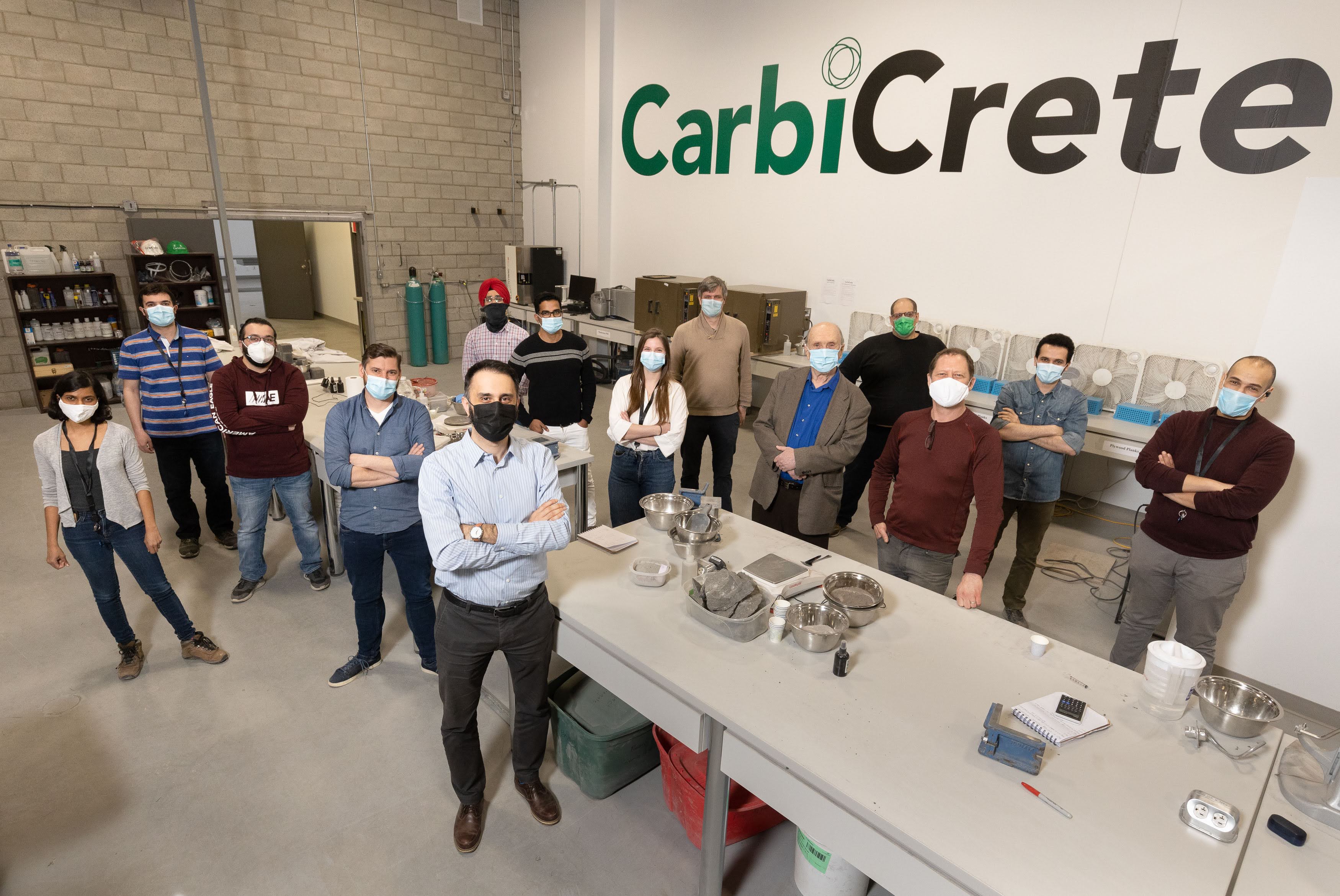
Joining a new industry, saving an old one
Indeed, there are more than 350 companies in the cleantech sector in Quebec, providing close to 9,000 jobs and generating revenues of more than $1 billion. All of this presages well for the future of the economy as the world faces the reality that all economies must greenify their activity if we are to avoid the consequences wrought by climate change.
CarbiCrete has an important role to play in this green transformation. In their specific area of operation, the potential for CO2 reduction is enormous. It could also revitalize the entire industry.
Way back in 1956, Quebec was Canada’s leader in cement production, making over 1.5 million tons of the stuff. And while neighbouring Ontario has since taken over the title of number one producer in the county, growth has been stagnant and even declining in the last few years. In Quebec, however, the sector is seeing double-digit growth.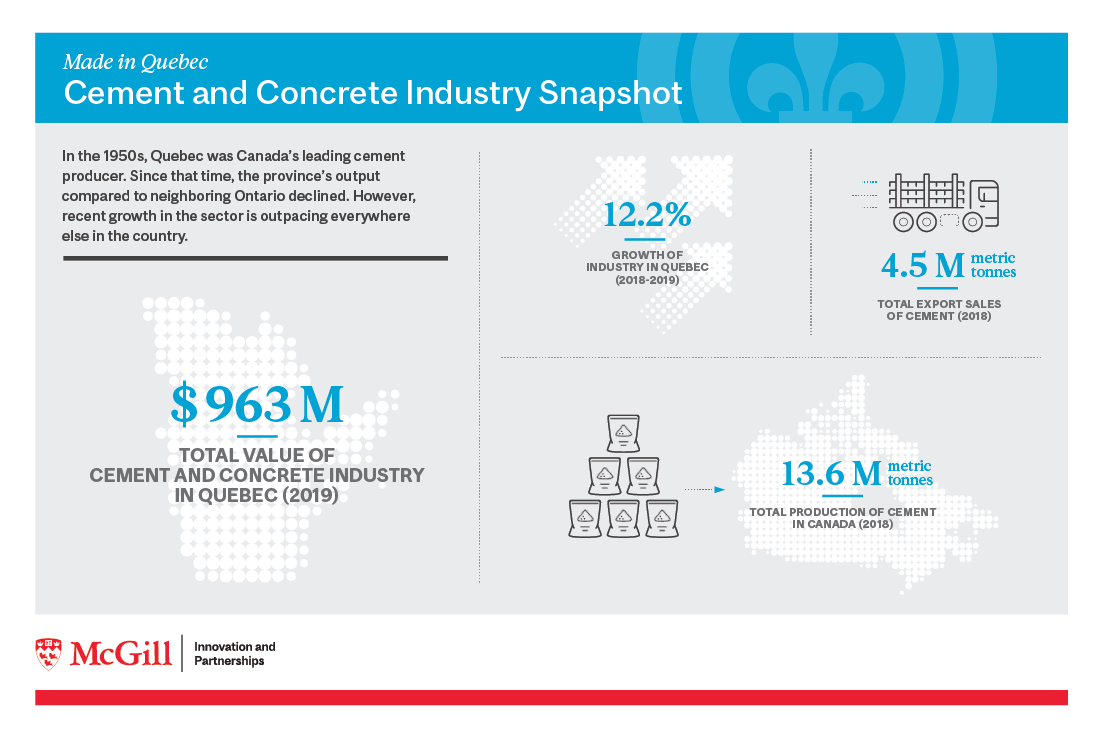
One of the main drivers behind this increase is the McInnis Cement plant in Port-Daniel–Gascons, Gaspe. A massive and controversial investment of over $1.5 billion, the plant has a capacity of 2.2 million tons per year of cement, the largest in the province. But it also produces an estimated 1.8 million tonnes of greenhouse gases annually. Growing this industry comes with a price.
CarbiCrete, with their cost-saving, carbon-offsetting, strength-increasing formula, may hold the key to a new way forward – a product that makes money and saves the planet at the same time. This is the promise of build back better, done right.

